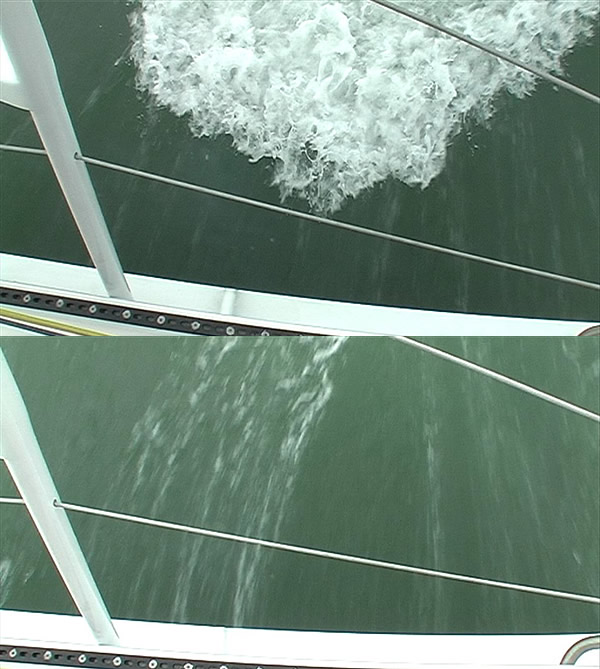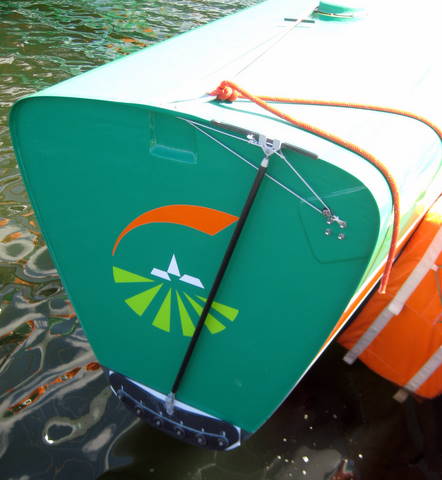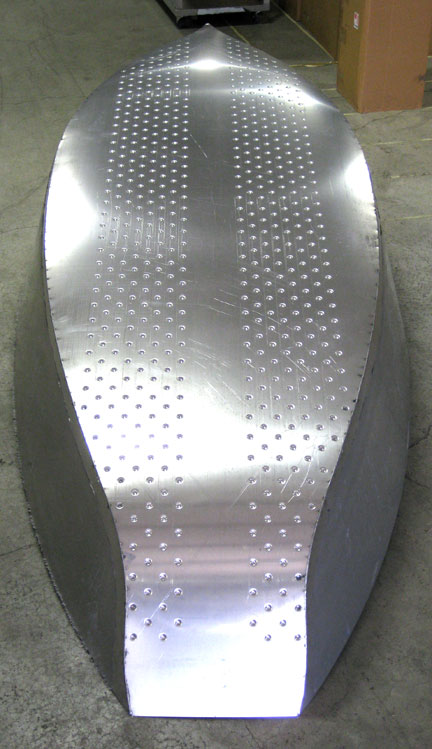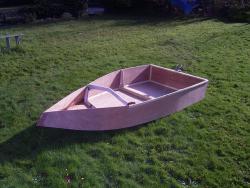CCC 2013
123456
... 8
123456
... 8
|
|
Lot's of interesting stuff here. My apologies for being absent from the debate - I recently had another (rather large and uncomfortable) hernia repaired, and have been knocked for six a bit for the past week.
First off, some of the boats were running at surprisingly high Froude numbers. The general rule of thumb is that the Froude number for a displacement boat is around 1.34 (hence the "1.34 x sq rt of the waterline length in feet" method for estimating max displacement speed). If you assume that all the boats were 16ft long, with about a 15ft waterline length, then they should have only been able to reach around 5kts. Dennis knows that he was doing about 6kts, I was perhaps 1kt slower at most, given the time it took for him to overtake me. Joe was probably doing around 8kts or so at a guess, perhaps a little more. Dennis was probably running at a Froude number of around 1.55, Joe at a Froude number of around 2.00. Joe's boat was clearly well up its own bow wave and would almost certainly have planed had it had flatter sections aft, IMHO. Despite me getting my weight as far forward as I could in the boat (well forward of the C of B) I couldn't keep the bow down, so clearly my boat must have been right at the point where it was trying to climb over the hump, too, despite the lower speed. In general terms, catamarans have a higher hull resistance for a given displacement than a monohull or stabilised tri. The reason is that they tend to have both a higher wetted area and suffer from interference drag from the waves between the two hulls. The HPB people have pretty much proved this by experiment, too, with most fast HPBs now being similar in configuration to Dennis' boat. At this relatively low weight and speed, hydrofoils need about the same power, perhaps slightly more, than a planing hull. Although the lift drag ratio of the foils themselves is significantly better than that for a hull, the added drag from the surface piercing supports and the added weight reduces any advantage to near zero. One problem is that it is hard to accurately predict the power needed for a planing hull at these low weights and speeds, as the normal methods used (like Savitsky's method) aren't truly valid in this operating region. My gut feeling is that a very light planing hull probably needs less power than Savitsky's would predict, based on the very limited power that is developed by a dinghy or windsurfer rig. A 10m² sail on a board sailing at 10kts on a broad reach, with a relative wind speed of 10kts (i.e. alpha = 45 deg) will be generating about 180W of propulsive power. This is comparable to that from a single cordless drill and significantly less than the power predicted by any planing boat power prediction method I've seen. Clearly it should be quite possible to make a planing hull for this competition, but the secret is going to be dealing with the point Dennis has raised, how to overcome the narrow efficient speed range of the propeller. Dennis and I were excellent examples of the problem, albeit for slightly different reasons. Dennis had a propeller that was very well matched to the cruise speed of his boat, but which struggled to provide enough low speed thrust to accelerate the relatively high weight of his hull. I had the advantage of a much lighter hull, but I was overly optimistic when choosing my propeller pitch, and ended up running with the blades far too heavily loaded for the true speeds the hull was capable of. The light weight still allowed good acceleration though, even with the mismatched prop. To work well, a planing boat of this light a weight and power almost needs two propulsion systems if it is going to work over a wide speed range with limited power; a low speed thrust set up to give good acceleration and a high speed thrust set up to then continue to accelerate the boat up and on to the plane and beyond. This is similar to the systems used on some warships. Years ago I did some sea trials on the T23 when it first entered service. That used big diesel electric systems to get to around 15 to 18kts, then the Spey gas turbines kicked in and gave the boat a real shove as it accelerated towards it's maximum of over 30kts (we took Norfolk to around 33kts during acceptance trials, and joked that we could have water skied behind her!). I suspect that a very light hull, with enough planing area to keep the surface loading down, might just be able to get away with a big prop mismatch at low speeds. Certainly Quackers seemed to accelerate fairly well, even though the prop was running a long way from optimum at low speeds (it would have given of it's best at around 9 kts, much faster than the boat could go in practice). I've since run Quackers with a lower pitch prop of slightly smaller diameter, and she is slightly faster (I managed 5.8kts on a single drill), with much quicker acceleration (she takes about 3.5 seconds to go from a standstill to maximum speed). There's no way that she will plane though, as the stern just buries itself in the water as the speed increases. |
|
|
Jeremy
Your propeller tests confirm my thoughts that I will need a smaller faster propeller with a reduced pitch to increase the acceleration. Additionally I am applying a super slippery layer to the planing surface which could lower the frictional drag by up to 40 %. I have been told that this will not work by one expert but I considered that he did not understand how this was being applied. All the published data on planning boats indicate that you can not plane at these low speeds with such low power. However I keep thinking of the kids playing at the sea edge on small circular discs, jumping on their disc after throwing it in front. These plane, but this is due to the very shallow water that is trapped between the disc and sand and their very low weight . Dennis |
|
|
There's a paradox here, because windsurfers plane with much less power than methods such as Savitsky's give. The example I gave earlier of a 10m² sail delivering around 180W on a reach in a 10kt wind is pretty typical. We know that windsurfers plane well at this sort of speed, in fact IIRC some use non-buoyant boards, so all the lift is coming dynamically from their speed. My gut feeling, from re-reading all of Savitsky's published work, is that he didn't ever look closely at what happens down at waterline lengths of less than 5m, with beam/effective wetted length ratios of less than around 4 or 5. Savitsky took the view that a planing hull always operates with a very low aspect ratio (i.e. low beam, high wetted length) so that flow is predominantly spanwise (i.e. the flow runs outwards as much as, or more than, rearwards). This very significantly changes the effective lift coefficient, and therefore changes the induced drag coefficient. In the case of a relatively short, wide, hull, then the rearward component of the flow direction (when planing) is going to be greater than for a long, narrow, hull. This means that the lift coefficient will increase and the induced drag coefficient will decrease. The viscous drag component should be around the same, effectively dependent almost entirely on the wetted area and velocity. Because viscous drag diminishes rapidly with increasing velocity, and induced drag dominates from the least total resistance point onwards (the big dip in the middle of the total resistance vs pitch angle plot, often referred to as the "drag bucket"), I'm not sure that any surface coating is going to make an appreciable difference in practice (although it might help psych out the opposition!). Certainly the virtual wind tunnel software I have (which can deal with water as well as air) shows that changing the skin surface properties only alters viscous drag by a couple of percent at best, primarily because the majority of viscous drag is generated by the boundary layer interaction, particularly as the critical Reynolds number is approached as velocity increases. |
|
|
My empirical theory is that the Windsurfing route is the way to go - something flat that just supports a skipper with dynamic balance skills.
Those who ate all the pies will be at a disadvantage. 
|
|
|
In reply to this post by Jeremy
Hi Jeremy,
About planing hulls, maybe you should consider a very strange "anti-Coanda" device called "Platex", or "Midship Interceptor" by Jürgen Sass ( http://sassdesign.net/InterceptorpresentationengJGK%20JS.pdf )
You just have to cut a big hole in your hull : ask Paul, it's quite funny .....
and put a "hand brake board" in the hole :-)
An other way to get your hull out of the water would be to kick the rubber rail, as we did on sport dinghies, many years ago ...
I didn't manage to insert picts about Platex...(just got a tiny blue square) : they are on an old Nautical Trek page http://www.nauticaltrek.com/12516-scarab-16-le-retour-d-experience-de-merran-et-trevor , comment # 10
hope this will help
Eric
|
|
|
I was involuntarily in touch with Jurgen Sass around a year ago, he was trying to push his "interceptor" theories on me back then!
Are these the pictures, Eric (I can't seem to make them appear any larger):    Or was it this one with the dimples:  (I've missed the one with the other sort of "dimples"!) |
|
|
Dimples do work.
My business colleagues say that friction on wind turbines can be reduced 7% using a laser to produce pits in the surface. Also artificial hip joints can reduce friction by a similar method, the pits (10 micron pitch) store fluid between the joints which reduces friction. Also lasered micro-pits can emulate a shark skin, which has low friction in one direction. It's a Nano-Technology thing, with lots of on-going laser research. -Paul |
|
|
In reply to this post by Jeremy
Jeremy
I agree with your statement that my coating (might help psych out the opposition)as at present I am not giving out details of the skin surface coating. I do not want any one using this and beating me with it. I can say that this has been tested, not by me, and shows real promise but not in the exact application that I am using. I think that the dimples shown on the sail boat could not reduce the friction as much as my coating. Dennis |
|
|
Roughening the surface seems to work when the Reynolds number is around the transition from laminar to turbulent flow. around the critical Reynolds number, viscous drag can increase quite rapidly, before dropping again once the flow has fully tripped into turbulence. Adding surface roughness can make the transition occur at a slightly lower Reynolds number, which may then result in less viscous drag over the speed range of interest.
It's highly dependent on effective length and velocity though. If you have, say, a hull wetted waterline length of only 1m and a velocity of 1m/S, then the wetted part of the hull is going to be operating right around the critical Reynolds number, which is usually around 1,000,000. Dimples or other surface irregularities may well cause the critical Reynolds number to reduce to around 800,000 or perhaps less, so moving the transition point and resulting in a reduction in viscous drag. If you kept this very short hull, but increased the speed to, say, 5m/S, then there would be no need for dimples, as the Reynolds number would be well into the fully turbulent flow region, at 5,000,000. Alternatively, say you had a really short hull, of only 0.2m, then even at 5m/S it is still going to be running at around the critical number and the flow may benefit from being tripped earlier. As you reduce the size, the speed at which there is a benefit from encouraging early transition increases. The other important area is to look at what happens below a Reynolds number of around 1,000,000. Here flow will be laminar, and the viscous drag will be low and significantly affected by surface roughness. Smooth, highly polished, surface, with a high molecular surface energy (materials like PTFE, for example) will give reduced viscous drag. The problem is that the speeds where this is effective are well below those for the size of boat we're looking at for this competition. if your boat has a 4m effective wetted waterline length, then it will transition from laminar to turbulent flow at around 0.25 m/S (about 1/2kt). At any speed greater than this the flow will be fully turbulent and relatively unaffected by the surface finish. More important (in my view) than the surface finish is the hull shape and gross features, such as steps or aeration mechanisms. These are likely to have a far greater effect than any surface finish, I think. |
|
|
AirGlider
I had thought that I had just about finished the main hull, unfortunately when working on the planing surface I realized that the small 70 mm V will stop the low drag process from working. I am now cutting the boat bottom so that it can be pulled completely flat on the planning surface. This will not be as good as the original surface and sadly increase the weight. Dennis 
|
|
|
Looks good, Dennis.
The problem with the vee hull is that is significantly changes the flow direction over the hull. Much of the flow over the vee'd part of a hull will be outward, rather than aft, and this hits the power requirement pretty hard, largely as a consequence of lifting all that water up and out to the sides. A flat hull is far less directionally stable and more prone to slamming, but does tend to result in the flow being better aligned with the direction of travel and should use less power. |
|
|
In reply to this post by Jeremy
the "other type" is unfortunately the only one I've experienced (you get used to, but they are not very effective).
But I would like to know if the anti-Coanda "Platex-Interceptor" really works. Did anybody make tests ?? |
|
|
Nigel Irens works on LDL boats that seem to go much faster than the standard expected speeds.
A 26' launch here at 11 knots http://www.youtube.com/watch?feature=player_embedded&v=kEYfUMLks1s And this 50' storming along http://www.youtube.com/watch?feature=player_embedded&v=EltG5I-xMk4 http://www.nigelirens.com/ldl/index.php Brian |
|
|
Looks good Brian, but it's got about 100 cordless drills in it.
I'm still sceptical about planing. There seem to be too many "ifs". I'm not saying it won't work, just that I'm not knowledgeable enough to understand it. Probably planing will be the only way to go at some point in the future when the boats have developed enough, but in the meantime how about gettting a pair of old A Class cat hulls off Ebay http://www.ebay.co.uk/itm/Pair-of-Catamaran-Hulls-18-feet-ex-Unicorn-/360533022540?pt=UK_Sporting_Goods_Sailing_Boats_ET&hash=item53f171574c and doing something with one of them. I think that Jeremy told us that a 10sq m winsurfer sail developed about the same power as a cordless. The A Class has 15 sq m, so 1.5 cordless's. And how fast will an A Class cat do? Easily 10knots +. John |
|
|
Thing is, the LDL boats are going faster than standard hull speed without planing. That's my point.
Long narrow and light, just like cat hulls. Also my sailing canoe could be pressed hard because of the outriggers which were clear of water nearly all the time. In strong winds she would break hull speed and surge forward , same speed as planing but not the same as planing on a wide stern. It;s clear long narrow and light can exceed hull speed, so for the CCC with length fixed, the winner will be the narrowest and lightest - ie very young person helming!! Brian |
|
|
The Froude number is proportional to length and displacement, and it's this that determines "hull speed". It's commonplace to use a single number for it, like 1.34, but in reality you can get up to a Froude number of around 2 or more before the hull starts to plane. This isn't something that new, as many old motor boats, designed back when engine power was quite limited, used much the same design tricks as Nigel Irens has.
For those into maths, the oft quoted rule-of-thumb that says that maximum displacement speed (in kts) = 1.34 x sq rt waterline length (in ft) only really applies to relatively heavy, beamy, boats. Once you increase the waterline length and reduce the displacement the Froude number increases, so increasing the hull speed before the onset of planing. You can calculate the Froude number for a small boat if you know the maximum speed before the onset of planing (which is usually taken as the speed when the bow wave peak intersects the aft edge of the waterline, so the boat is sitting in the trough between it's own bow wave). The formula is Fr = v / sq rt waterline length, where v is in kts and waterline length is in feet. This is only appropriate for relatively small, light boats, for ships you needs something that takes account of the acceleration due to gravity. So, if you have a 16ft boat that has a maximum measured displacement speed of 8kts, then it will have a Froude number (or SL ratio) of 8 / sq rt 16 = 2 significantly greater than the 1.34 that's commonly bandied about as a limit. In the case of Nigel Irens Greta, then at 11kts and 26ft she has an Fr of 2.16, not unreasonable for a light boat with a long waterline. For comparison (and getting back on topic) Joe's boat in the CCC this year was running at around an Fr of 2, on just a few hundred watts. |
|
|
AirGlider
Hi Jeramy I fail to see the real value of the Froude number but I need to achieve planning at the lowest possible speed. If correct, I believe that my short water line length of only 6.3 ft will greatly help but I can not see any other design points to help. Dennis 
|
|
|
Dennis, if you want to reduce the speed at which the transition to planing occurs, then increase the beam and decrease the waterline length, just as you've done. As with all things boaty, less weight means less power needed for a given speed.
The best you can probably do to optimise planing efficiency is to adjust the boat trim so that the pitch angle matches the lift requirement (i.e. the total boat and crew weight) at the best speed you can get. This can be quite a fine adjustment, and is one reason why big planing boats often have trim tabs to adjust pitch. It's more efficient to move crew weight fore and aft, but there might be a fairly wide range of movement needed. At low speed the weight needs to be aft, to get a high pitch angle and so good low speed lift, and higher speed the angle needs to be lowered to reduce drag yet maintain high lift. |
|
|
In reply to this post by Dennis A
Jeremy, thanks for that. What happens at speeds above 2. Do narrow hulls then plane?
This site claims 30 knots for the 20' long Tornado. https://www2.bc.edu/~reidal/tornado.htm Brian |
«
Return to General Discussion
|
1 view|%1 views
| Free forum by Nabble | Edit this page |

